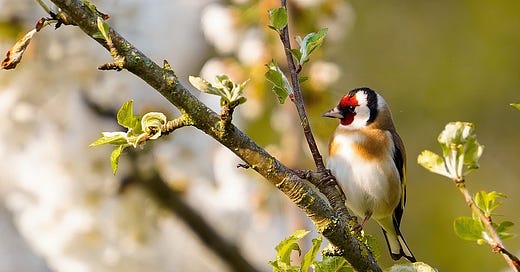The tricky, tinkling sounds of the goldfinch run through both their song and contact calls, and are given incessantly both in flight and when perched.
The sound is most readily confused with that of other finches.
In wooded areas and gardens the closest is generally greenfinch. Goldfinches can trill rather like a greenfinch, but overall their song is faster and more chaotic, and it lacks that distinctive drawn out sneering that the greenfinch likes to throw in.
In more open country, linnets are the likeliest confusion. Linnets sing with a similar fast rush of sweet notes, and hang around in groups like goldfinches do, so it can be worth spending some time practising whether you’ve got a goldfinch or linnet in your ear.
Daubed in scarlet, gold, black, white and warm browns, there’s something toy-like about both the sight and sound of these birds.
One way to get to know the noise is to find yourself a good patch of thistles or teasel and wait for a ‘charm’ of goldfinches to appear. They will invariably let you know they’re coming with that tinkling sound, and arrive with a buoyant flight.
With a little patience you can get prolonged views of them in this context. A few will continue to tinkle away as they flit between seed heads, the ground and the nearest bush, where you may notice one or two of the birds keeping lookout while the rest feed. And you will certainly hear them call again when they take flight together, and flash that gold in their wings.
Many of us can now expect goldfinches close to home too. In the last 20 years they have charmed their way into British gardens, becoming one of our most recorded species.
This is thought to be much to do with trends in garden feeding. Goldfinches aren’t too keen on peanuts but they are drawn to sunflower hearts and nyjer seed, which are now deployed by many people in return for a close encounter.
A low-cost alternative is to let your dandelions grow. You may find that goldfinches appear just as magically as the dandelion heads do in an unmown lawn.



